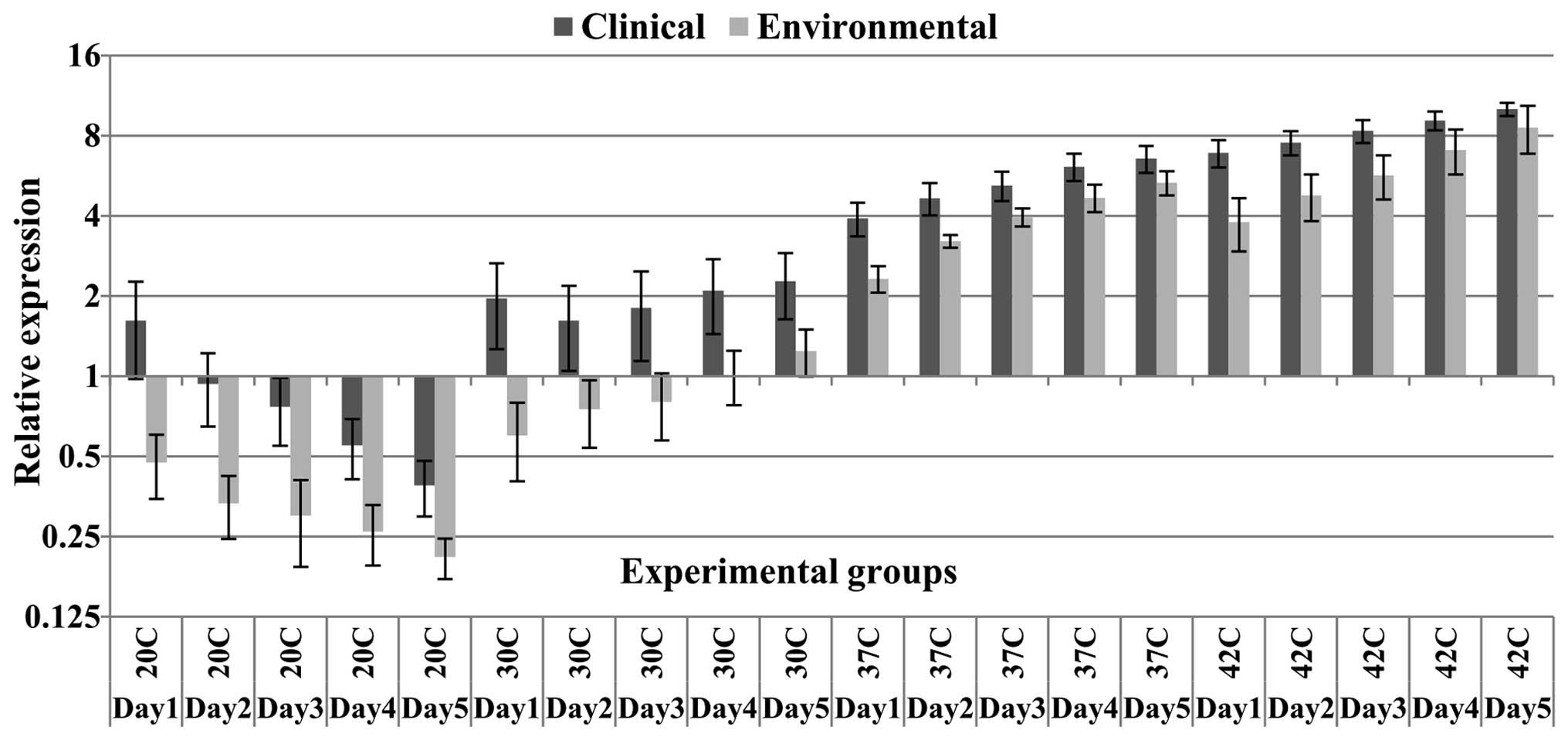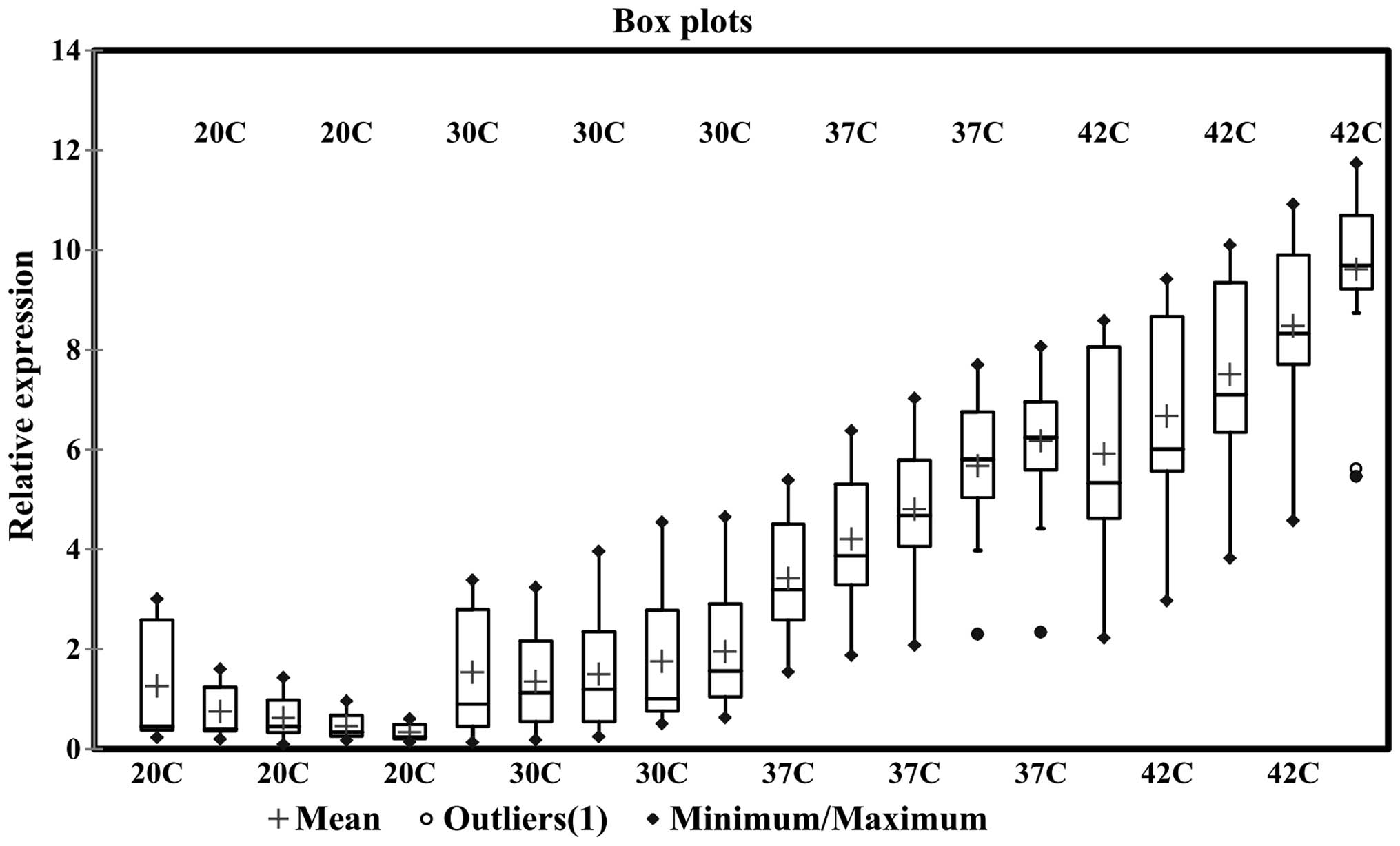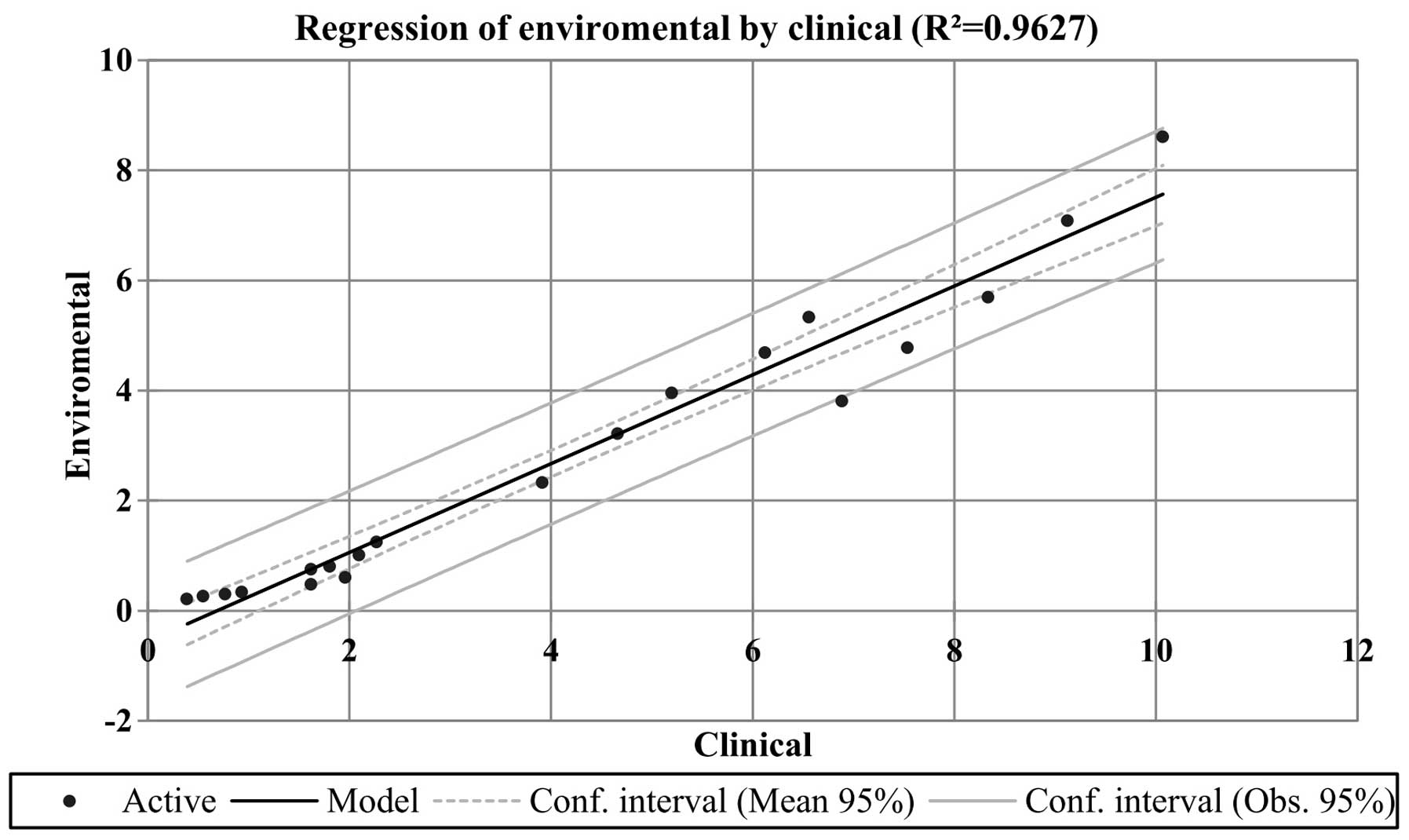|
1
|
Latgé JP: Aspergillus fumigatus and
aspergillosis. Clin Microbiol Rev. 12:310–350. 1999.PubMed/NCBI
|
|
2
|
Dagenais TR and Keller NP: Pathogenesis of
Aspergillus fumigatus in invasive aspergillosis. Clin Microbiol
Rev. 22:447–465. 2009. View Article : Google Scholar : PubMed/NCBI
|
|
3
|
Denning DW: Invasive aspergillosis. Clin
Infect Dis. 26:781–803; quiz 804–805. 1998. View Article : Google Scholar : PubMed/NCBI
|
|
4
|
Gugnani HC: Ecology and taxonomy of
pathogenic aspergilli. Front Biosci. 8:s346–s357. 2003. View Article : Google Scholar : PubMed/NCBI
|
|
5
|
Fedorova ND, Nierman WC, Turner G, Joardar
V, Maiti R, Anderson MJ, Denning DW, Wortman JR, Goldman GH and
Osmani SA: A comparative view of the genome of Aspergillus
fumigatus. The Aspergilli: Genomics, Medical Aspects, Biotechnology
and Research Methods. Goldman GH and Osmani SA: CRC Press, Taylor
& Francis Group; pp. 25–38. 2008
|
|
6
|
Lin SJ, Schranz J and Teutsch SM:
Aspergillosis case-fatality rate: Systematic review of the
literature. Clin Infect Dis. 32:358–366. 2001. View Article : Google Scholar : PubMed/NCBI
|
|
7
|
Nierman WC, Pain A, Anderson MJ, Wortman
JR, Kim HS, Arroyo J, Berriman M, Abe K, Archer DB, Bermejo C, et
al: Genomic sequence of the pathogenic and allergenic filamentous
fungus Aspergillus fumigatus. Nature. 438:1151–1156. 2005.
View Article : Google Scholar : PubMed/NCBI
|
|
8
|
Latgé JP: Aspergillus fumigatus and
aspergillosis. Clin Microbiol Rev. 12:310–350. 1999.PubMed/NCBI
|
|
9
|
Burnie JP, Carter TL, Hodgetts SJ and
Matthews RC: Fungal heat-shock proteins in human disease. FEMS
Microbiol Rev. 30:53–88. 2006. View Article : Google Scholar : PubMed/NCBI
|
|
10
|
Westerheide SD, Raynes R, Powell C, Xue B
and Uversky VN: HSF transcription factor family, heat shock
response, and protein intrinsic disorder. Curr Protein Pept Sci.
13:86–103. 2012. View Article : Google Scholar
|
|
11
|
Albrecht D, Guthke R, Brakhage AA and
Kniemeyer O: Integrative analysis of the heat shock response in
Aspergillus fumigatus. BMC Genomics. 11:322010. View Article : Google Scholar : PubMed/NCBI
|
|
12
|
Inouye S, Katsuki K, Izu H, Fujimoto M,
Sugahara K, Yamada S, Shinkai Y, Oka Y, Katoh Y and Nakai A:
Activation of heat shock genes is not necessary for protection by
heat shock transcription factor 1 against cell death due to a
single exposure to high temperatures. Mol Cell Biol. 23:5882–5895.
2003. View Article : Google Scholar : PubMed/NCBI
|
|
13
|
Feige U and Polla BS: Hsp70-a multi-gene,
multi-structure, multi-function family with potential clinical
applications. Experientia. 50:979–986. 1994. View Article : Google Scholar : PubMed/NCBI
|
|
14
|
Feige U and Polla BS: Hsp70-a multi-gene,
multi-structure, multi-function family with potential clinical
applications. Experientia. 50:979–986. 1994. View Article : Google Scholar : PubMed/NCBI
|
|
15
|
Jolly C and Morimoto RI: Role of the heat
shock response and molecular chaperones in oncogenesis and cell
death. J Natl Cancer Inst. 92:1564–1572. 2000. View Article : Google Scholar : PubMed/NCBI
|
|
16
|
Allendoerfer R, Maresca B and Deepe GS Jr:
Cellular immune responses to recombinant heat shock protein 70 from
Histoplasma capsulatum. Infect Immun. 64:4123–4128. 1996.PubMed/NCBI
|
|
17
|
Mayer MP and Bukau B: Hsp70 chaperones:
Cellular functions and molecular mechanism. Cell Mol Life Sci.
62:670–684. 2005. View Article : Google Scholar : PubMed/NCBI
|
|
18
|
Owczarzy R, Tataurov AV, Wu Y, Manthey JA,
McQuisten KA, Almabrazi HG, Pedersen KF, Lin Y, Garretson J,
McEntaggart NO, et al: IDT SciTools: A suite for analysis and
design of nucleic acid oligomers. Nucleic Acids Res. 36(Web Server
issue): W163–W169. 2008. View Article : Google Scholar : PubMed/NCBI
|
|
19
|
Schoonjans F, Zalata A, Depuydt CE and
Comhaire FH: MedCalc: A new computer program for medical
statistics. Comput Methods Programs Biomed. 48:257–262. 1995.
View Article : Google Scholar : PubMed/NCBI
|
|
20
|
Livak KJ and Schmittgen TD: Analysis of
relative gene expression data using real-time quantitative PCR and
the 2 (-Delta Delta C (T)) Method. Methods. 25:402–408. 2001.
View Article : Google Scholar
|
|
21
|
Zugel U and Kaufmann SH: Role of heat
shock proteins in protection from and pathogenesis of infectious
diseases. Clin Microbiol Rev. 12:19–39. 1999.PubMed/NCBI
|
|
22
|
Tereshina VM: Thermotolerance in Fungi:
The role of heat shock proteins and trehalose. Mikrobiologiia.
74:293–304. 2005.In Russian. PubMed/NCBI
|
|
23
|
Nicholls S, MacCallum DM, Kaffarnik FA,
Selway L, Peck SC and Brown AJ: Activation of the heat shock
transcription factor Hsf1 is essential for the full virulence of
the fungal pathogen Candida albicans. Fungal Genet Biol.
48:297–305. 2011. View Article : Google Scholar :
|
|
24
|
Brown AJ, Budge S, Kaloriti D, Tillmann A,
Jacobsen MD, Yin Z, Ene IV, Bohovych I, Sandai D, Kastora S, et al:
Stress adaptation in a pathogenic fungus. J Exp Biol. 217:144–155.
2014. View Article : Google Scholar :
|
|
25
|
Bhabhra R, Miley MD, Mylonakis E, Boettner
D, Fortwendel J, Panepinto JC, Postow M, Rhodes JC and Askew DS:
Disruption of the Aspergillus fumigatus gene encoding nucleolar
protein CgrA impairs thermotolerant growth and reduces virulence.
Infect Immun. 72:4731–4740. 2004. View Article : Google Scholar : PubMed/NCBI
|
|
26
|
Chang YC, Tsai HF, Karos M and Kwon-Chung
KJ: THTA, a thermotolerance gene of Aspergillus fumigatus. Fungal
Genet Biol. 41:888–896. 2004. View Article : Google Scholar : PubMed/NCBI
|
|
27
|
Dirr F, Echtenacher B, Heesemann J,
Hoffmann P, Ebel F and Wagener J: AfMkk2 is required for cell wall
integrity signaling, adhesion, and full virulence of the human
pathogen Aspergillus fumigatus. Int J Med Microbiol. 300:496–502.
2010. View Article : Google Scholar : PubMed/NCBI
|
|
28
|
Wagener J, Echtenacher B, Rohde M, Kotz A,
Krappmann S, Heesemann J and Ebel F: The putative
alpha-1,2-mannosyltransferase AfMnt1 of the opportunistic fungal
pathogen Aspergillus fumigatus is required for cell wall stability
and full virulence. Eukaryot Cell. 7:1661–1673. 2008. View Article : Google Scholar : PubMed/NCBI
|
|
29
|
Zhou H, Hu H, Zhang L, Li R, Ouyang H,
Ming J and Jin C: O-Mannosyltransferase 1 in Aspergillus fumigatus
(AfPmt1p) is crucial for cell wall integrity and conidium
morphology, especially at an elevated temperature. Eukaryot Cell.
6:2260–2268. 2007. View Article : Google Scholar : PubMed/NCBI
|
|
30
|
Leach MD, Tyc KM, Brown AJ and Klipp E:
Modelling the regulation of thermal adaptation in Candida albicans,
a major fungal pathogen of humans. PLoS One. 7:e324672012.
View Article : Google Scholar : PubMed/NCBI
|
|
31
|
Leach M and Cowen L: To sense or die:
Mechanisms of temperature sensing in fungal pathogens. Curr Fungal
Infect Rep. 8:185–191. 2014. View Article : Google Scholar
|
|
32
|
Metzger MB and Michaelis S: Analysis of
quality control substrates in distinct cellular compartments
reveals a unique role for Rpn4p in tolerating misfolded membrane
proteins. Mol Biol Cell. 20:1006–1019. 2009. View Article : Google Scholar :
|
|
33
|
Geiler-Samerotte KA, Dion MF, Budnik BA,
Wang SM, Hartl DL and Drummond DA: Misfolded proteins impose a
dosage-dependent fitness cost and trigger a cytosolic unfolded
protein response in yeast. Proc Natl Acad Sci USA. 108:680–685.
2011. View Article : Google Scholar :
|
|
34
|
Satyanarayana C, Schröder-Köhne S, Craig
EA, Schu PV and Horst M: Cytosolic Hsp70s are involved in the
transport of aminopeptidase 1 from the cytoplasm into the vacuole.
FEBS Lett. 470:232–238. 2000. View Article : Google Scholar : PubMed/NCBI
|
|
35
|
Daugaard M, Rohde M and Jäättelä M: The
heat shock protein 70 family: Highly homologous proteins with
overlapping and distinct functions. FEBS Lett. 581:3702–3710. 2007.
View Article : Google Scholar : PubMed/NCBI
|
|
36
|
Verghese J, Abrams J, Wang Y and Morano
KA: Biology of the heat shock response and protein chaperones:
Budding yeast (Saccharomyces cerevisiae) as a model system.
Microbiol Mol Biol Rev. 76:115–158. 2012. View Article : Google Scholar : PubMed/NCBI
|
|
37
|
Bonner JJ, Carlson T, Fackenthal DL,
Paddock D, Storey K and Lea K: Complex regulation of the yeast heat
shock transcription factor. Mol Biol Cell. 11:1739–1751. 2000.
View Article : Google Scholar : PubMed/NCBI
|
|
38
|
Cerqueira GC, Arnaud MB, Inglis DO,
Skrzypek MS, Binkley G, Simison M, Miyasato SR, Binkley J, Orvis J,
Shah P, et al: The Aspergillus genome database: Multispecies
curation and incorporation of RNA-Seq data to improve structural
gene annotations. Nucleic Acids Res. 42(Database Issue): D705–D710.
2014. View Article : Google Scholar :
|
|
39
|
De Virgilio C, Simmen U, Hottiger T,
Boller T and Wiemken A: Heat shock induces enzymes of trehalose
metabolism, trehalose accumulation, and thermotolerance in
Schizosaccharomyces pombe, even in the presence of cycloheximide.
FEBS Lett. 273:107–110. 1990. View Article : Google Scholar : PubMed/NCBI
|
|
40
|
Piper PW: Molecular events associated with
acquisition of heat tolerance by the yeast Saccharomyces
cerevisiae. FEMS Microbiol Rev. 11:339–355. 1993. View Article : Google Scholar : PubMed/NCBI
|
|
41
|
Argüelles JC: Thermotolerance and
trehalose accumulation induced by heat shock in yeast cells of
Candida albicans. FEMS Microbiol Lett. 146:65–71. 1997. View Article : Google Scholar : PubMed/NCBI
|
|
42
|
Wu C: Heat shock transcription factors:
Structure and regulation. Annu Rev Cell Dev Biol. 11:441–469. 1995.
View Article : Google Scholar : PubMed/NCBI
|
|
43
|
Do JH, Yamaguchi R and Miyano S: Exploring
temporal transcription regulation structure of Aspergillus
fumigatus in heat shock by state space model. BMC Genomics.
10:3062009. View Article : Google Scholar : PubMed/NCBI
|
|
44
|
Chen KU and Chen ZC: Heat shock proteins
of thermophilic and thermotolerant fungi from Taiwan. Bot Bull Acad
Sin. 45:247–257. 2004.
|
|
45
|
McCusker JH, Clemons KV, Stevens DA and
Davis RW: Saccharomyces cerevisiae virulence phenotype as
determined with CD-1 mice is associated with the ability to grow at
42 degrees C and form pseudohyphae. Infect Immun. 62:5447–5455.
1994.PubMed/NCBI
|
|
46
|
Debeaupuis JP, Sarfati J, Chazalet V and
Latgé JP: Genetic diversity among clinical and environmental
isolates of Aspergillus fumigatus. Infect Immun. 65:3080–3085.
1997.PubMed/NCBI
|
|
47
|
Wang S, Diller KR and Aggarwal SJ:
Kinetics study of endogenous heat shock protein 70 expression. J
Biomech Eng. 125:794–797. 2003. View Article : Google Scholar
|
|
48
|
Werner-Washburne M, Becker J,
Kosic-Smithers J and Craig EA: Yeast Hsp70 RNA levels vary in
response to the physiological status of the cell. J Bacteriol.
171:2680–2688. 1989.PubMed/NCBI
|
|
49
|
Tepšič K, Gunde-Cimerman N and Frisvad JC:
Growth and mycotoxin production by Aspergillus fumigatus strains
isolated from a saltern. FEMS Microbiol Lett. 157:9–12. 1997.
View Article : Google Scholar
|
|
50
|
Shapiro RS, Uppuluri P, Zaas AK, Collins
C, Senn H, Perfect JR, Heitman J and Cowen LE: Hsp90 orchestrates
temperature-dependent Candida albicans morphogenesis via Ras1-PKA
signaling. Curr Biol. 19:621–629. 2009. View Article : Google Scholar : PubMed/NCBI
|
|
51
|
Low SY, Dannemiller K, Yao M, Yamamoto N
and Peccia J: The allergenicity of Aspergillus fumigatus conidia is
influenced by growth temperature. Fungal Biol. 115:625–632. 2011.
View Article : Google Scholar : PubMed/NCBI
|
|
52
|
Schade B, Jansen G, Whiteway M, Entian KD
and Thomas DY: Cold adaptation in budding yeast. Mol Biol Cell.
15:5492–5502. 2004. View Article : Google Scholar : PubMed/NCBI
|
|
53
|
Sahara T, Goda T and Ohgiya S:
Comprehensive expression analysis of time-dependent genetic
responses in yeast cells to low temperature. J Biol Chem.
277:50015–50021. 2002. View Article : Google Scholar : PubMed/NCBI
|
|
54
|
Murata Y, Homma T, Kitagawa E, Momose Y,
Sato MS, Odani M, Shimizu H, Hasegawa-Mizusawa M, Matsumoto R,
Mizukami S, et al: Genome-wide expression analysis of yeast
response during exposure to 4 degrees C. Extremophiles. 10:117–128.
2006. View Article : Google Scholar
|
|
55
|
Aguilera J, Randez-Gil F and Prieto JA:
Cold response in Saccharomyces cerevisiae: New functions for old
mechanisms. FEMS Microbiol Rev. 31:327–341. 2007. View Article : Google Scholar : PubMed/NCBI
|
|
56
|
Berman J and Sudbery PE: Candida albicans:
A molecular revolution built on lessons from budding yeast. Nat Rev
Genet. 3:918–930. 2002. View
Article : Google Scholar : PubMed/NCBI
|
|
57
|
Swoboda RK, Bertram G, Budge S, Gooday GW,
Gow NA and Brown AJ: Structure and regulation of the HSP90 gene
from the pathogenic fungus Candida albicans. Infect Immun.
63:4506–4514. 1995.PubMed/NCBI
|
|
58
|
Zeuthen ML and Howard DH: Thermotolerance
and the heat-shock response in Candida albicans. J Gen Microbiol.
135:2509–2518. 1989.PubMed/NCBI
|


















